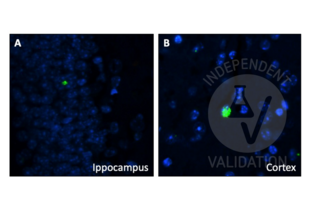APP antibody (AA 190-290)
-
- Target See all APP Antibodies
- APP (Amyloid beta (A4) Precursor Protein (APP))
-
Binding Specificity
- AA 190-290
-
Reactivity
- Human
-
Host
- Rabbit
-
Clonality
- Polyclonal
-
Conjugate
- This APP antibody is un-conjugated
-
Application
- Western Blotting (WB), Immunohistochemistry (IHC)
- Sequence
- AEESDNVDSA DAEEDDSDVW WGGADTDYAD GSEDKVVEVA EEEEVAEVEE EEADDDEDDE DGDEVEEEAE EPYEEATERT TSIATTTTTT TESVEEVVRE V
- Cross-Reactivity
- Human
- Characteristics
- Polyclonal Antibodies
- Purification
- Affinity purification
- Immunogen
- A synthetic peptide corresponding to a sequence within amino acids 190-290 of human APP (NP_000475.1).
- Isotype
- IgG
- Top Product
- Discover our top product APP Primary Antibody
-
-
- Application Notes
- WB,1:500 - 1:2000,IHC,1:50 - 1:200
- Restrictions
- For Research Use only
-
- by
- Prof. Merighi, Laboratory of Neurobiology, Department of Veterinary Sciences, University of Turin
- No.
- #104427
- Date
- 05/12/2022
- Antigen
- APP
- Lot Number
- 3100080101
- Method validated
- Immunohistochemistry
- Positive Control
Adult (24 months) mouse brain
3-month-old Taconic mouse Model 1349 brain fixed in 4% paraformaldehyde
- Negative Control
We incubated slices overnight with the blocking solution only and then processed them with the secondary antibody.
- Notes
The anti-APP antibody (Amyloid beta (A4) Precursor Protein) C-Term ABIN3020680 works in IHC-P, especially at higher concentrations (1:50 and 1:100), and without the use of any antigen retrieval treatment.
- Primary Antibody
- ABIN3020680
- Secondary Antibody
- goat anti-rabbit AF488-conjugated antibody (Invitrogen by Thermo Fisher Scientific, A11034, lot 1971418)
- Full Protocol
- Perfuse mice with paraformaldehyde 4% in 0.1 M phosphate buffer pH 7.4 and post-fix in the same fixative for an additional 2 h at RT.
- Wash, dehydrate, and embed samples in paraffin wax.
- Wash several times with 0.01 M PBS.
- Cut intestines and brain with a microtome into 6µm sections and mount on glass slides.
- After paraffin removal, incubate sections for 1 h at RT in PBS containing 1% albumin from chicken egg white (Sigma, A5378) and 0.3% Triton-X-100 (BioRad, 161-0407, lot 00583) to block non-specific binding sites.
- Incubate sections with primary anti-APP antibody (Amyloid beta (A4) Precursor Protein) (N-Term) (antibodies Online, ABIN3020680, lot 3100080101) diluted 1:50, 1:100, and 1:200 in PBS-BSA-PLL ON at RT.
- Wash sections 3x 5 min with 0.01 M PBS.
- Incubate sections with secondary goat anti-rabbit AF488-conjugated antibody (Invitrogen by Thermo Fisher Scientific, A11034, lot 1971418) diluted 1:500 in 0.1 M PBS for 1 h at RT.
- Wash sections 3x 5 min with 0.01M PBS.
- Mount specimens in Fluoroshield (Sigma, F6182, lot MKCB0153V).
- Acquire images with a fluorescence microscope and appropriate filter settings for AF488, e.g. Leica DM 6000B fluorescence microscope equipped with a digital camera at 40x magnification.
- Experimental Notes
Antigen retrieval treatment was also tested. In this case, sections were processed for microwave antigen retrieval for 10 min (95-100 °C) in 10 mM sodium citrate buffer (pH 6.0). After 20 min of spontaneous cooling, sections were washed twice for 5 min with distilled water and for 5 min with PBS.
Validation #104427 (Immunohistochemistry)![Successfully validated 'Independent Validation' Badge]()
![Successfully validated 'Independent Validation' Badge]() Validation ImagesFull Methods
Validation ImagesFull Methods -
- Format
- Liquid
- Buffer
- PBS with 0.02 % sodium azide,50 % glycerol, pH 7.3.
- Preservative
- Sodium azide
- Precaution of Use
- This product contains Sodium azide: a POISONOUS AND HAZARDOUS SUBSTANCE which should be handled by trained staff only.
- Handling Advice
- Avoid freeze / thaw cycles
- Storage
- -20 °C
- Storage Comment
- Store at -20°C. Avoid freeze / thaw cycles.
-
- Target
- APP (Amyloid beta (A4) Precursor Protein (APP))
- Alternative Name
- APP (APP Products)
- Background
- This gene encodes a cell surface receptor and transmembrane precursor protein that is cleaved by secretases to form a number of peptides. Some of these peptides are secreted and can bind to the acetyltransferase complex APBB1/TIP60 to promote transcriptional activation, while others form the protein basis of the amyloid plaques found in the brains of patients with Alzheimer disease. In addition, two of the peptides are antimicrobial peptides, having been shown to have bacteriocidal and antifungal activities. Mutations in this gene have been implicated in autosomal dominant Alzheimer disease and cerebroarterial amyloidosis (cerebral amyloid angiopathy). Multiple transcript variants encoding several different isoforms have been found for this gene.,AAA,ABETA,ABPP,AD1,APPI,CTFgamma,CVAP,PN-II,PN2,Amyloid beta A4,APP,Aβ42,preA4,Epigenetics & Nuclear Signaling,Transcription Factors,Signal Transduction,G protein signaling,Cell Biology & Developmental Biology,Apoptosis,Immunology & Inflammation,IL-6 Receptor Signaling Pathway,Neuroscience,Neurodegenerative Diseases,Amyloid Plaque and Neurofibrillary Tangle Formation in Alzheimer's Disease,Neurodegenerative Diseases Markers,APP
- Molecular Weight
- 34 kDa/72-86 kDa
- Gene ID
- 351
- UniProt
- P05067
- Pathways
- Caspase Cascade in Apoptosis, EGFR Signaling Pathway, Transition Metal Ion Homeostasis, Skeletal Muscle Fiber Development, Toll-Like Receptors Cascades, Feeding Behaviour
-


 (1 validation)
(1 validation)



